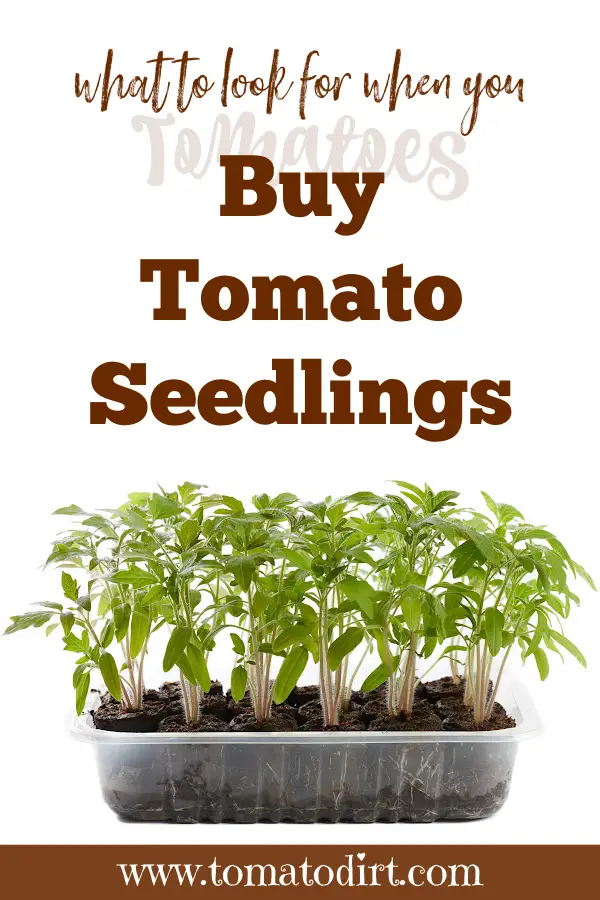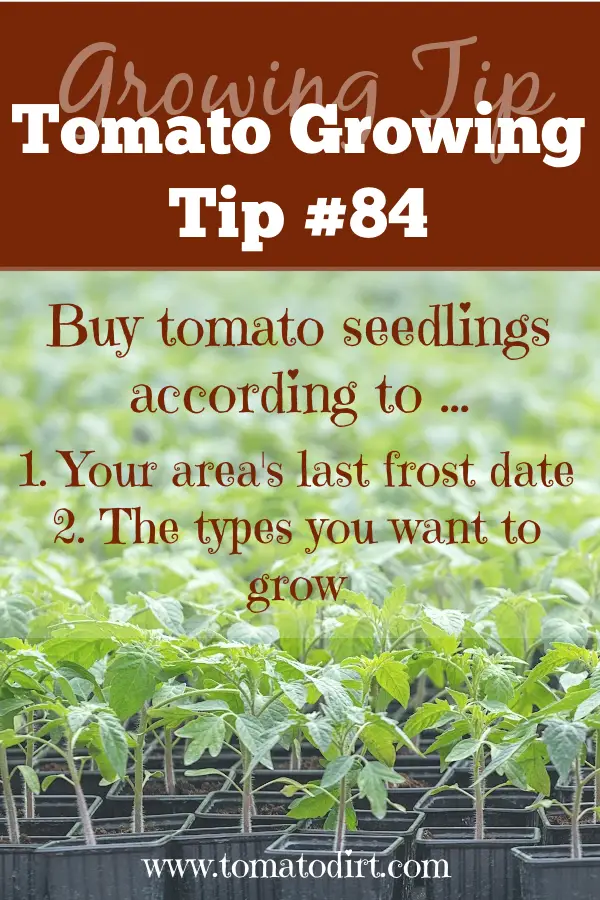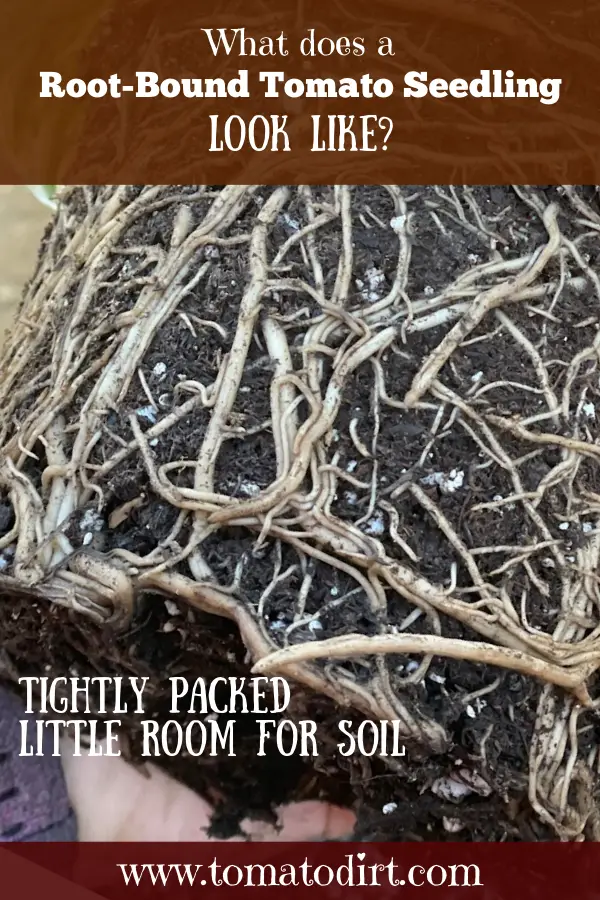FREE: 10 Must-Know Tomato Growing Tips Get The Guide
Read our affiliate disclosure here.
How to Buy Tomato Seedlings: A Gardener’s Guide
Since 2010, Tomato Dirt has garnered 4.8+ million views, making it the web’s leading online source for growing tomatoes in the home garden. Award-winning writer and Tomato Dirt owner Kathy Widenhouse has helped thousands of home gardeners grow healthier tomatoes. Be one of them when you get Tomato Dirt’s Growing Guide here.
Posted 4.2.24
If you’d like to grow tomatoes – but you may be intimidated or lack a lot of extra time – you can buy tomato seedlings and get your growing season off to a strong start.
Gardeners of all levels of experience buy tomato plants rather than starting tomatoes from seeds. With a few extra tips, you can know what to look for when you head off to the garden center to pick out your fledgling tomato plants. But first, take a gander at the many advantages you’ll have when you start this year’s garden with seedlings in hand.
If you buy tomato seedlings, you can …
- Get faster results. Seeds require time to germinate and grow into mature plants. But seedlings are established plants. You can set them in your garden sooner than when you start tomatoes from seeds, which means an earlier harvest – and a longer one.
- Reduce risk. If you’re a new gardener, you can lower the variables that can lead to failure with seed starting. Growing tomato plants from seeds requires proper conditions like temperature, light, and moisture – not difficult, by any means, but still a bit of a learning curve. And if you’re a new gardener, you can eliminate a few beginner problems by purchasing tomato seedlings the first season or two and build on your success later on. For instance, you won’t need to read up on germination issues and damping off disease. And you won’t need to worry about sustaining young plants while they accumulate a few sets of leaves and strengthen their stems.
- Enjoy the convenience. Gardeners plant tomato seeds indoors 6-8 weeks before their outdoor planting date. That’s up to two extra months of effort – not to mention space – to nurture seedlings into healthy plants. But when you buy tomato seedlings, you save that initial investment of time and effort – energy you can invest in planning your garden and preparing the beds. Seedlings are typically for sale at the right time for planting in your specific growing zone, ensuring that you start with plants that are suited to the current season and climate conditions.
- Get expert advice. Buy seedlings at a nursery or garden center and you can take advantage of the staff. They are experienced gardeners who can offer provide valuable advice and guidance on caring for tomatoes in your specific gardening climate. They will give you tips about watering, fertilizing, and managing pests that frequent gardens in your area – all of which is especially beneficial for new gardeners.
- Save money. When you start tomatoes from seeds you need to purchase seedling trays, potting soil, and even grow lights. That can be a big financial layout if you want to grow just a few plants. While buying seedlings has an upfront cost, it can potentially be more cost-effective if you want to grow just a few plants – or if you’re a beginner.
Tips for buying tomato seedlings: where, when, what
Like many other home gardeners, take advantage of the hundreds of tomato seedlings available at the start of the season and buy tomato seedlings. Use these tips. You’ll get a jumpstart on this year’s crop.
Where to look for tomato seedlings
- Local retail outlets. Start your search at local nurseries and garden centers. They carry a variety of tomato seedlings suited for your region's climate and soil conditions. Tomato seedlings sold in Sacramento, CA are different varieties than those in Sheffield, UK.
- Farmers' markets. Check out the farmers' markets in your area. But don’t wait until planting season. Ask the vendors if they plan to sell seedlings and when they’ll be ready. This way you’ll be first in line for their best stock.
- Local garden clubs. Keep an eye out for plant exchanges and sales, which clubs and extension services use as fundraisers. Gardening hobbyists are generous with their expertise and eager to inspire new gardeners.
- Online retailers. If you prefer convenience, check out online vendors like Burpee that specialize in selling tomato seedlings, other vegetables, herbs, and flowers. You can purchase plants ahead of time. Retailers will alert you when the seedlings are ready to send and will mail them at the proper planting time for your area.
When to buy tomato seedlings
The best time to buy tomato seedlings depends on two different factors.
1. What’s your area’s last frost date?
Tomato seedlings are available locally about a month before the last frost date in your area. However, tomatoes do best when planted 10-14 days after the last frost date, which allows time for the ground to warm. However, that doesn’t mean you must wait to buy tomato seedlings. You can get them early, especially if you prefer a typical variety, want the healthiest plants, or are concerned that local retailers will sell out. Just make sure you have a place to nurture your new babies, keep them warm, strengthen them, and help them harden off so they’re ready to set in the garden when the time is right.
And to that point – maybe you’ve been in your local garden center right around the last frost date in your area. If so, you’ve experienced the crush of enthusiastic gardeners as seedlings fly off the shelves. If you wait too long, you may not get to choose your favorite tomato varieties to grow. Or you may have to settle for less healthy seedlings.
2. What types of tomatoes do you want to grow?
Different tomato varieties mature in different lengths of time – that is, the number of days from transplant time to harvest. Short-season tomatoes are ready to be picked 70 days or less after being transplanted into the garden. Mid-season tomatoes take 70-80 to mature and long season tomatoes (late season tomatoes) are not ready for harvesting for 80 days or more – up to about 120.
How do you know if a tomato seedling is short-season, mid-season, or long season? Seedling labels may or may not provide you with this information. But if you study varieties beforehand you can be prepared to know what types of tomato seedlings to buy and when. For example, the Fourth of July Tomato is a short-season variety. Fruit can reach maturity in 49 days – just 7 weeks – after you set it out in the garden. If you plant these seedlings in your garden by May 15, you can expect to harvest your first fruits in early July.
So you should plan to buy tomato seedlings not just according to the calendar, but also on how long the fruit of a particular tomato variety takes to mature.
What to look for when you buy tomato seedlings
- Healthy stems and foliage. Choose seedlings with vibrant green leaves and sturdy stems. Be on the lookout for dark green foliage at this stage, which indicates the plant has been given excess nitrogen while still developing. All that extra can shock your seedlings when they’re set into the real world – your garden. Also, avoid tomato seedlings with yellowing or wilted leaves. Drooping or fading foliage indicates stress, disease, or overwatering.
- A strong root system. Check a tomato seedling’s roots by gently removing the plant from its container. Carefully grasp the base of the cell. Lift the plant out slowly and look at its base. If you see plenty of white, healthy roots that are not overly crowded or root-bound, you’ve got a winner. Steer clear of seedlings with roots that are tightly wrapped around the container or protrude from the bottom. You’ll have to trim them to remove the seedling from the cell to plant it. That means stress for the plant and a subsequent struggle to get established in your garden. On the other hand, if roots do not extend through the potting soil all the way to the bottom of the seedling cell – but are clearly quite shallow – then the root system is not mature enough to sustain transplanting without shock. https://www.tomatodirt.com/tomato-transplanting-mistakes.html
- No signs of pests or diseases. Does that plant have spots or holes anywhere on the leaves or stem? Is the plant wilting or fragile? What about powdery mildew or sticky honeydew? Inspect the leaves and stems for telltale signs of vulnerability.
- Variety. Select tomato varieties that align with your gardening goals. For instance, if you’re looking for tomatoes can harvest within a short window in order to make sauce or for canning, then be sure you choose determinate tomatoes. Or perhaps you don’t have much room. In that case, choose a bush variety that won’t sprawl or require staking.
What to avoid when you buy tomato seedlings
- Overgrown seedlings. Steer clear of seedlings that are leggy
or that are curved in one direction. Their elongated stems and sparse leaves
indicate that they have been reaching for light. Weak stems are prone to
breaking or bending during transplanting and later, under the weight of fruit
or during adverse weather conditions.
Further, leggy seedlings may have used up much of their energy reserves trying to grow taller rather than developing a strong root system and foliage. They need more space between plants when planted in the garden, as their height can lead to crowding and competition for nutrients and sunlight. In short, overgrown seedlings mean reduced productivity, smaller fruit, and lower yield compared to well-balanced seedlings. Look for tomato seedlings with strong central stems and compact, balanced foliage. - Root-bound seedlings. A tomato seedling with tightly packed roots can’t absorb nutrients and water effectively. This can lead to weaker plants that are more susceptible to stress, diseases, and pests. Root-bound plants have a harder time establishing themselves when transplanted into the garden or larger containers. Once you extract the root-bound tomato plant from its container, you need to separate the roots so they will spread. That often means using a knife to cut the bottom of the roots – ouch! These plants then struggle to spread their roots properly, leading to continued issues with nutrient uptake and overall growth. Instead, look for plants with strong, white roots that fill the container but are not tightly coiled or circling the pot.
- Blossoms on seedlings. Healthy young tomato plants typically
do not have blossoms. Like other children or adolescents, they’re not quite
ready to reproduce. Flowering requires energy and resources, which is why blossoms
on tomato seedlings can indicate overfertilizing – an approach some garden
vendors take in order to present “more mature” seedlings to customers. A healthy tomato plant prioritizes
establishing a strong root system and developing healthy foliage before it
starts flowering and producing fruit.
Another reason to avoid buying tomato seedling with blossoms: transplant shock. When tomato seedlings are transplanted into the garden or larger containers, they experience a period of adjustment. During this time, the plant focuses on acclimating to its new environment. Meanwhile, existing blossoms battle for energy to move into the fruiting stage -- or blossoms drop altogether. The result is slower fruiting and a longer transition for the plant from seed tray to garden. - Unlabeled plants. Mystery tomato varieties can produce plenty of fruit … or not. If possible, choose labeled seedlings that clearly indicate the variety and their specific growing requirements.
Use these extra tips when you buy tomato seedlings
- Ask for recommendations. Talk with nursery staff, your local garden extension, or experienced gardeners in your area for recommendations on tomato varieties that perform well in your region.
- Consider organic seedlings. If you’d like to try organic gardening, you can find certified organic tomato seedlings that are grown without synthetic pesticides or fertilizers.
- Transplant carefully. One of the biggest tomato gardening hurdles is transplanting. Help your young tomato plants make the transition successfully. When transplanting seedlings into your garden, handle them gently to avoid damaging the roots. Water thoroughly after planting to help them establish quickly.
Whether you’re a new gardener or a seasoned pro, use these tips to choose the healthiest tomato seedlings for your garden.
More about buying and planting tomatoes
Planting tomatoes: top tips to help your new crop succeed ...
How to choose tomato varieties for your garden ...
How to buy tomato plants through the mail ...
Preparing your soil for planting tomatoes in the home garden...
Best
and worst companion plants for tomatoes ...
Tomato transplanting mistakes to avoid when setting out plants ...
Get helpful tips for planting tomatoes on our Pinterest board...
Return from How To Buy Tomato Seedlings to Tomato Dirt home
As an Amazon Associate and Rakuten Advertising affiliate I earn from qualifying purchases.
SHARE THIS PAGE:
FREE! 10 Must-Know Tomato Growing Tips: 20-page guide
Get yours here:






